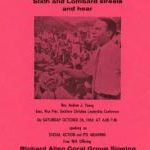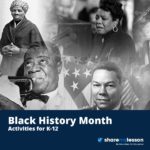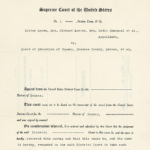When most people think of the Civil Rights Movement in America, they think of Martin Luther King, Jr. delivering his “I Have a Dream” speech on the steps of the Lincoln Memorial in 1963 and receiving the Nobel Peace Prize the following year. But “the Movement” achieved its greatest results — the 1964 Civil Rights Act and the 1965 Voting Rights Act — due to the competing strategies and agendas of diverse individuals. Even black Americans, the primary beneficiaries of this landmark legislation, did not agree on the tactics that should be used to secure the equal protection of their rights. This unit presents the views of several important black leaders who shaped the debate over how to achieve freedom and equality in a nation that had long denied a portion of the American citizenry the full protection of their rights.
Declaration Revisited: Black Americans Podcast
This is the first of three revisits to the Declaration of Independence; three communities to which the tenets of life, liberty, and the pursuit of happiness did not apply. Byron Williams, author of The Radical Declaration, walks us through how enslaved Americans and Black Americans pushed against the document from the very beginning of our nation’s founding.
This short episode includes a one-page Graphic Organizer for students to take notes on while listening, as well as discussion questions on the back side.
Learn About Black History, Culture and Politics
Learn about Black history in the United States before and after the Civil War; the Civil Rights Movement; the history of Africa; African American art; and African American trailblazers.
Civil Rights in Pennsylvania

Throughout the twentieth century, blacks in Pennsylvania employed numerous strategies to achieve the civil rights they deserved. Their efforts for to receive their rights began with a strategy of New Deal liberalism in the 1940s and 50s headed by prominent black leaders. When attempts to rewrite the laws using the established political system failed, black leaders encouraged more direct action, like boycotts and sit-ins. The movement quickly took on a black nationalist approach. Philadelphia became the perfect place for several Black Power conferences and home of the short-lived, though active, Black Panther Party.
Jim Crow Wisdom: Memory and Identity in Black America Since 1940
James Basker & Johnathan Holloway discuss the novel written by Mr. Holloway, Jim Crow Wisdom: Memory & Identity in Black America Since 1940.
Black History Month Lesson Plans & Resources

This February, start your Black History Month lesson planning with Share My Lesson’s expanded collection. The Share My Lesson team has curated a collection of free lessons, worksheets, and activities for educators to use to teach preK-12 students about key events and individuals whose accomplishments continue to influence us today.
Brown v. Board of Education Lesson Collection

On May 17, 1954 the Brown v. Board of Education decision was made. This landmark Supreme Court decision declared that laws establishing separate public schools for black and white children were unconstitutional. The Brown v. Board of Education ruling overturned the Plessy v. Ferguson decision of 1896, which allowed state-sponsored segregation in public schools. To support teachers as they commemorate this important anniversary in their classes, the Share My Lesson team has selected a variety of free lesson plans, educational resources and classroom materials about equity, particularly in schools.
U.S. Supreme Court Decisions and Justices Who Made Them
“Who cares what old people in black robes say?” As an educator you care. The challenge is how do you get your students excited about Article III of the Constitution. Constituting America has organized 90 Supreme Court cases of influential and history-changing decisions in its Constitution Archives. Need a judicial decision on what you are studying? Find it here. Need a Supreme Court ruling on a current event? Find it here. You get the picture. The material you seek is here. Your challenge, should you accept it, is make it come alive to your students.
The Talented Tenth, W.E.B. DuBois
Black History Month Lesson Plans on Nonviolence
The power of nonviolent actions and attitudes as a means to resist oppression and spur reforms is a recurring feature of democratic and democratizing societies. The School Violence Prevention Demonstration Program presents educators with lesson plans that explore the use of nonviolence in history, paying particular attention to the civil rights movement and African American history. Six lessons address: the 1963 Children’s March; the concept of nonviolence using primary sources and stories of participants in the civil rights movement; the power of nonviolence; the story of Rosa Parks; citizenship schools; how music can be used to achieve social and political change.
